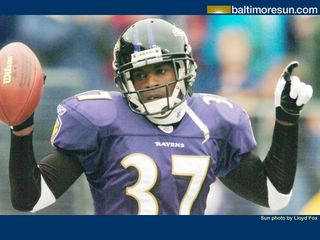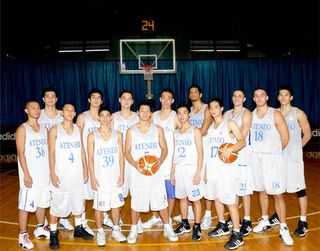Manny and Roy -- Peas in a Pod
Pacman fever seems less infectious after Manny Pacquiao's third-round knockout of Erik Morales last week than it was after he defeated Morales in January or when he beat Oscar Larios last July. That's not a huge surprise, considering there was nothing particularly thrilling about the way Manny beasted Morales this time around. Pacquiao avenged his previous loss to El Terible in the January fight, which made it a huge cause for celebration, and while no one expected Larios to be much of a challenge for Pacman, the mere fact that the fight was held in Manila guaranteed that the local hype machine would be set on overdrive.
Although the Pacquiao-inspired euphoria has been less widespread and enduring than after his previous fights, it hasn't stopped Filipino sports journalists from going Buckwild in their Manny-worship. One of the Solar Sports commentators at latest Morales fight called Manny the pound-for-pound best fighter in the world. While Manny looks like he's probably the best fighter at 129 pounds, anyone who thinks he's better than Floyd Mayweather Jr. needs to cut down on the hallucinogens. However, the bogus pound-for-poung claim made me realize just how much Manny Pacquiao has in common with the former pound-for-pound king, Roy Jones, Jr.
For starters, both fighters have a passion for that grand, old sport of kings, cockfighting. Oh wait, horse racing is the sport of kings, not cockfighting, which is more like the international pauper's pastime. Anyplace where you can find men who smoke a lot and love gambling, you'll find cockfighting, or sabong, as it's called in Tagalog. Although in the Philippines, even the richest robber barons in the country aren't above rolling up their sleeves, strapping a couple razor blades to their roosters' talons and sending them into battle. Pacquiao, who comes from a humble background in Mindanao's General Santos city, is filthy stinking rich now, but rather than developing a taste for polo and squash, Pacman has stayed true to his roots and reputedly bought hundreds of fighting cocks to breed and send into battle, and, I presume, also to provide employment for his male family members. It's sort of like Manny's miniature version of the New Deal. Instead of public works projects and the Tennessee Valley Authority, we have a clan of Pacquiaos feeding the roosters, training them, breeding them, and making sure they're game for battle. Roy Jones Jr. was one of the last public figures in the United States willing to stand up for cockfighting. He was a serious breeder for years until Congress made it illegal to own fighting cocks even if they never fought within the United States. Most famously, Roy beat James Toney with a right hook out of a crouching, hesitation move that he said he learned from watching gamecocks go at it.
But the true mind-meld between Manny and Roy Jones Jr. is found not in the cockpit arena or the boxing ring, but on the microphone. Both are accomplished singers. Being Filipino, however, Manny may not have a choice. In the United States, we laughed at Eddie Murphy, Bruce Willis and Deion Sanders when they recorded terrible records. In the Philippines, if you're famous and don't have a song, then you really aren't famous. Pacquiao's endorsement deal with X-treme Magic Sing videoke machines probably also figures into his recording career. Think of the synergy potential in the TV commercials. Manny Pacquiao, the magic sing "Champion sa Kantahan," can sing the videoke version of the Manny Pacquiao hit, "Para sa'yo ang Laban na 'to." In English, that's "This Fight's For You." The song is a straight-up monster ballad, the kind you might hear on a 1980s rock compilation like the ones advertised on Spike TV around 3:17 a.m. The only difference is that passion in Manny Pacquiao's voice, that deep-set emotion that says "I love my people, I fight for them" and sounds like a whiny hinge. Roy puts a lot of feeling into his music, too, but his style is less heart-felt and inspirational. Instead, Roy's "Y'All Must've Forgot" is a musical version of a round in the ring with Jones Jr. He's furious, attacking you relentlessly with shattering blows and guttural, cringe-worthy noises. In as much time as it would take for Roy to knock you out in a fight, you'll be wishing you were unconscious after listening to his music.
Here are a couple YouTube clips, one of Roy's legendary video for "Y'All Must've Forgot," which is notable for pretty much everything in it, but the numerous close-ups of Roy doing the soulful head nod with his eyes closed and the shots of Roy's sons wearing his championship belts are visual haiku at its finest. Also hilarious is Jones' boast at the end about beating Vinny Pazienza, which is akin to Michael Jordan bragging after outplaying Vernon Maxwell or George W. Bush talking smack after winning a primary against Alan Keyes. Sadly the Pacquiao song doesn't have a real video on YouTube, but since it absolutely must be heard, I'm posting a bizarre spoof video that plays the song in its entirety.
What's next for Pacquiao and Jones Jr.? The parameters of the answer are limited only by one's imagination. Jones could re-patriate himself in the Philippines and bring a little of his Dirty South gamecock wizardry to Pacquiao's flock of cocks. That hardly seems unlikely, however. I'm shooting for the stars -- I want a Christmas duets album.
Although the Pacquiao-inspired euphoria has been less widespread and enduring than after his previous fights, it hasn't stopped Filipino sports journalists from going Buckwild in their Manny-worship. One of the Solar Sports commentators at latest Morales fight called Manny the pound-for-pound best fighter in the world. While Manny looks like he's probably the best fighter at 129 pounds, anyone who thinks he's better than Floyd Mayweather Jr. needs to cut down on the hallucinogens. However, the bogus pound-for-poung claim made me realize just how much Manny Pacquiao has in common with the former pound-for-pound king, Roy Jones, Jr.
|
I think I see Roy Jones Jr. somewhere in the background! |
For starters, both fighters have a passion for that grand, old sport of kings, cockfighting. Oh wait, horse racing is the sport of kings, not cockfighting, which is more like the international pauper's pastime. Anyplace where you can find men who smoke a lot and love gambling, you'll find cockfighting, or sabong, as it's called in Tagalog. Although in the Philippines, even the richest robber barons in the country aren't above rolling up their sleeves, strapping a couple razor blades to their roosters' talons and sending them into battle. Pacquiao, who comes from a humble background in Mindanao's General Santos city, is filthy stinking rich now, but rather than developing a taste for polo and squash, Pacman has stayed true to his roots and reputedly bought hundreds of fighting cocks to breed and send into battle, and, I presume, also to provide employment for his male family members. It's sort of like Manny's miniature version of the New Deal. Instead of public works projects and the Tennessee Valley Authority, we have a clan of Pacquiaos feeding the roosters, training them, breeding them, and making sure they're game for battle. Roy Jones Jr. was one of the last public figures in the United States willing to stand up for cockfighting. He was a serious breeder for years until Congress made it illegal to own fighting cocks even if they never fought within the United States. Most famously, Roy beat James Toney with a right hook out of a crouching, hesitation move that he said he learned from watching gamecocks go at it.
|
But the true mind-meld between Manny and Roy Jones Jr. is found not in the cockpit arena or the boxing ring, but on the microphone. Both are accomplished singers. Being Filipino, however, Manny may not have a choice. In the United States, we laughed at Eddie Murphy, Bruce Willis and Deion Sanders when they recorded terrible records. In the Philippines, if you're famous and don't have a song, then you really aren't famous. Pacquiao's endorsement deal with X-treme Magic Sing videoke machines probably also figures into his recording career. Think of the synergy potential in the TV commercials. Manny Pacquiao, the magic sing "Champion sa Kantahan," can sing the videoke version of the Manny Pacquiao hit, "Para sa'yo ang Laban na 'to." In English, that's "This Fight's For You." The song is a straight-up monster ballad, the kind you might hear on a 1980s rock compilation like the ones advertised on Spike TV around 3:17 a.m. The only difference is that passion in Manny Pacquiao's voice, that deep-set emotion that says "I love my people, I fight for them" and sounds like a whiny hinge. Roy puts a lot of feeling into his music, too, but his style is less heart-felt and inspirational. Instead, Roy's "Y'All Must've Forgot" is a musical version of a round in the ring with Jones Jr. He's furious, attacking you relentlessly with shattering blows and guttural, cringe-worthy noises. In as much time as it would take for Roy to knock you out in a fight, you'll be wishing you were unconscious after listening to his music.
Here are a couple YouTube clips, one of Roy's legendary video for "Y'All Must've Forgot," which is notable for pretty much everything in it, but the numerous close-ups of Roy doing the soulful head nod with his eyes closed and the shots of Roy's sons wearing his championship belts are visual haiku at its finest. Also hilarious is Jones' boast at the end about beating Vinny Pazienza, which is akin to Michael Jordan bragging after outplaying Vernon Maxwell or George W. Bush talking smack after winning a primary against Alan Keyes. Sadly the Pacquiao song doesn't have a real video on YouTube, but since it absolutely must be heard, I'm posting a bizarre spoof video that plays the song in its entirety.
What's next for Pacquiao and Jones Jr.? The parameters of the answer are limited only by one's imagination. Jones could re-patriate himself in the Philippines and bring a little of his Dirty South gamecock wizardry to Pacquiao's flock of cocks. That hardly seems unlikely, however. I'm shooting for the stars -- I want a Christmas duets album.






